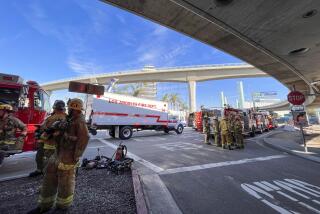THE SENSIBLE HOME : Alarm Detects Carbon Monoxide
- Share via
QUESTION: I heard that mild carbon monoxide (CO) poisoning has the same symptoms as a cold or the flu. My house is fairly airtight with new windows. What is the best method to check for CO?
ANSWER: Every year, CO kills more than 1,000 people in their sleep and sickens 10,000 more. Pregnant women, the unborn, elderly and children are particularly sensitive.
CO is a silent killer--odorless, colorless and tasteless. Early symptoms are headache, tiredness, nausea, etc. High CO concentrations can kill in 15 minutes.
Every house with gas, oil or wood heat is a candidate for high CO levels. Even in an older, less efficient house, there can be inadequate indoor air for complete combustion and venting.
Back-drafting often occurs when several appliances such as clothes dryer, bathroom vent fan and fireplace are simultaneously sucking air out of the house. If the furnace or water heater comes on too, CO-laden fumes can be sucked back down the flue into the house. Dirty gas ovens are another common source of CO.
To check for proper furnace combustion, observe the flames through the opening by the burners. Gas flames should be blue, even and have uniform shape. Flames with yellow tips and poorly defined edges indicate incomplete combustion. Heavy window condensation may indicate back-drafting.
Plug-in 120-volt CO alarms are most effective. There are also battery-operated models for locations away from an outlet. These require a replacement sensor/battery kit every three to five years.
Several CO alarms have a two-stage audible alarm and warning light. The light is green for normal. At a cautionary but not hazardous level, the light becomes amber and the alarm beeps every 30 seconds.
At this low level, there is time to open a window and search for the source. At a danger level, the light turns red and the alarm sounds continuously like a smoke alarm.
In areas with frequent power outages, select a 120-volt CO alarm with a battery backup. If your house has a burglar alarm, choose a CO alarm with a relay to trigger your burglar alarm and smoke alarm automatically.
CO-sensing tablets are an inexpensive (as low as $1.70) option. They turn dark when exposed to CO. Place several in your house.
Write for Update Bulletin No. 743 showing a buyer’s guide of 15 plug-in, battery and tablet CO alarms listing types of audible and visual alarm, number of stages, safety features, prices, a CO level/symptom chart and tips to reduce CO levels. Please include $2 and business-size SASE and mail to James Dulley, Los Angeles Times, 6906 Royalgreen Drive, Cincinnati, OH 45244.
An Energy Efficient Layout for the Kitchen
Q: We’re remodeling our kitchen and want it as energy efficient as possible. What are the best locations for our range and refrigerator?
A: Try to keep the refrigerator and range separated by at least 3 feet with a counter or cabinet between them. This will keep the hot oven and cold refrigerator from battling each other and wasting energy.
A refrigerator needs adequate air circulation through the condenser coils to operate efficiently. Place it along an open wall, not back in a corner or near a hot air register. The best location for the range is away from breezes or windows.
Drab Concrete Can Be a Thing of the Past
Q: I plan to build a greenhouse for plants and to also help heat my house. I want to use a concrete floor to store solar heat, but it is unattractive. What is the best way to add color to the floor?
A: Colorants can be added to concrete before it is poured to provide any color you want. If you use ordinary powdered colorants, make sure to mix them in thoroughly or the concrete will look blotchy.
There are new liquid colorants available, called Cement Color, for about $4 per bottle. One bottle will color two 80-pound bags of concrete. Liquid colorants are easier to mix in thoroughly than powders.
*
Letters and questions to Dulley, a Cincinnati-based engineering consultant, may be sent to James Dulley, Los Angeles Times, 6906 Royalgreen Drive, Cincinnati, OH 45244.
